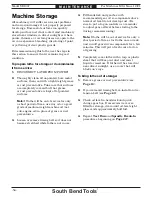
-58-
For Machines Mfd. Since 12/21
South Bend Tools
Model SB1007
S E R V I C E
Cross Slide
Tools Needed:
Qty
Hex Wrench 3mm .................................................1
Hex Wrench 5mm ................................................1
The cross slide backlash is adjusted by loosening
the cap screw shown in Figure 89, and then
tightening the accompanying set screw. This will
push down on a wedge and force the leadscrew
nut apart, taking up lash between the nut and
leadscrew.
Figure
Figure 89. Cross slide backlash components.
. Cross slide backlash components.
Set Screw
Set Screw
Cap Screw
Cap Screw
To adjust cross slide backlash:
1.
DISCONNECT LATHE FROM POWER!
2.
Remove compound rest. Loosen cap screw
(see Figure 89) located in middle T-slot of
cross slide.
3.
Rock cross slide handwheel back and forth,
and tighten set screw slowly until backlash
is approximately 0.002"–0.003", as indicated
on graduated dial.
Note:
If you end up adjusting the nut
too tightly, loosen the set screw, tap the
compound rest a few times with a rubber
or wooden mallet, and turn the handwheel
slowly back and forth until it moves freely—
then try again.
4.
Retighten cap screw when finished, then re-
install compound rest.
Gib Adjustment
The goal of adjusting the gib screws is to remove
sloppiness or "play" from the ways without over-
adjusting them to the point where they become
stiff and difficult to move.
In general, loose gibs cause poor finishes and
tool chatter; however, over-tightened gibs cause
premature wear and make it difficult to turn the
handwheels.
Before adjusting the gibs, loosen the locks for
each device so that the gibs can freely slide
during adjustment, then lubricate the ways.
The cross slide gib on this lathe is tapered
and held in position by a screw at each end of
the table. To adjust the gib, turn one screw
1
⁄
4
turn clockwise and the other screw
1
⁄
4
turn
counterclockwise, so both screws move in the
same direction and the same amount.
The compound rest and saddle gibs are flat bars
that exert pressure on the ways through four
set screws, which are secured in place by four
jam nuts. Test the feel of each slide by turning
the handwheel, and adjust the gib screws as
necessary to make the movement tighter or
looser.
The gib adjustment process usually requires
some trial and error. Repeat the adjustment
process as necessary until you find the best
balance between loose and stiff movement. Most
machinists find that the ideal gib adjustment is
one where a small amount of drag or resistance
is present, yet the handwheels are still easy to
move.
Содержание SB1007
Страница 84: ...southbendtools com Printed In U S A MN16349...



































